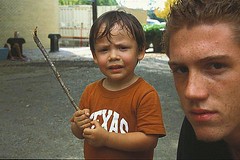
Toro, Dworsky, & Fowler (2007) report that youthful offenders are likely to experience homelessness disproportionately. For example, at one large youth shelter in New York, 30 percent of youth served had been arrested or incarcerated previously (Toro, et al., 2007). Additionally, because their homelessness forces them to spend more time than their housed peers in public spaces, homeless youth are more likely to have contact with the juvenile justice system for offenses such as loitering, camping, and panhandling (Sedlak & Bruce, 2010).
Youth Homelessness and Juvenile JusticeTheir offenses are generally non-violent but recurring, likely as a result of their lack of stable homes and frequent moves.
So begins the report entitled Best Practices In Interagency Collaboration: Youth Homelessness and Juvenile Justice (pdf) by the National Center for Homeless Education.
The report is designed to help juvenile justice professionals ranging from attorneys understand the structure of the juvenile court system and the McKinneyVento Homeless Assistance Act. This act is a critical tool homeless youth and the juvenile justice agencies that serve them to not only get them into school, but they work with to enroll and succeed in school. Obviously we support this approach, just take a look at our HumaneSmarts program just recently launched. After all, education is crucial to helping at-risk youth move forward into productive lives
Various groups worthy of support exist with this end in mind. In Pennsylvania there is The Homeless Children’s Education Fund, whose mission is listed on their website as follows:
To serve as a voice for the homeless children of Allegheny County and to ensure they are afforded equal access to the same educational opportunities and experiences as their peers.
Another useful resource comes to us through The U.S. Department of Education – a consolidated page of grants for the education of homeless youth. Of course the resources available at the national level can often be confusing to navigate, which brings me to a webpage compiled in the wake of Hurricane Katrina, Education Rights of Homeless Children by Michael A. O’Connor, Esq. on WriteLaw.
When the storm left 200,000 school age children homeless after it struck our part of the coast he saw the need to create a document that would allow people to know exactly what they had available to them. As a native of New Orleans myself I salute him for that, it’s a fantastic array of information and links to reseources, all presented in plain English.
The bottom line is that education is vital under the best of circumstances, but for the homeless children of our country it can make a fundamental difference between a life of incarceration and a life that is livable. The direct co
Image Source: i5a, used under it’s Creative Commons license









